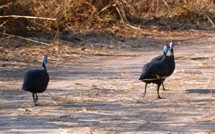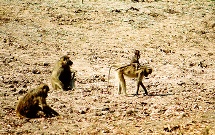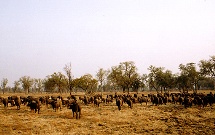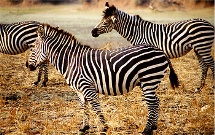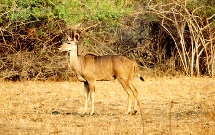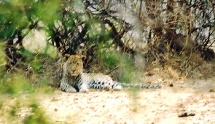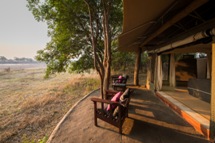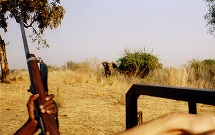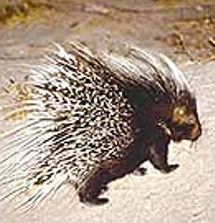Zambia (1): Day Nine : Kaingo Camp to Tena Tena
We were still very conscious that, although we had experienced a few half-decent glimpses, we were still short of the expected abundance of leopard sightings. However in the local language, ‘Kaingo’ means ‘leopard’, and this proved to be a good omen. No sooner had we finished our (very excellent ‘Full English’) breakfast than we spotted a leopard across the river, walking slowly along the opposite bank, and were able to view its stately progress for several minutes. It was a truly beautiful sight, as it strolled along by the edge of the river, its tail lifted high (with a wonderful circular curve at the top) to tell the panicking guinea fowl that it wasn’t hunting.
After leaving Kaingo we drove through 2-3 km of the ebony grove, observing an attempted puku mating (![]() ), guinea fowl (
), guinea fowl (![]() ), and numerous baboons (
), and numerous baboons (![]() ) by a lagoon. Further sights included a really long line of buffalo (
) by a lagoon. Further sights included a really long line of buffalo (![]() ), viewed along the horizon, lots of zebra (
), viewed along the horizon, lots of zebra (![]() ), and a kudu (
), and a kudu (![]() ). However the ‘main event’ was a further leopard just sprawled out under a tree at the top of the river bank, in a very relaxed frame of mind (
). However the ‘main event’ was a further leopard just sprawled out under a tree at the top of the river bank, in a very relaxed frame of mind (![]() ).
).
Tena Tena (![]() ) provided its customary warm greeting from host Daudi. However we all experienced the problem that always emerges after a long stay in a small bush camp, with only the people who you know around you, in that the prospect of having to meet and talk with half a dozen new faces just overwhelms you (this is why it is essential to ’wind down’ through a final base camp like this, rather than heading straight from the remote bush to the airport).
) provided its customary warm greeting from host Daudi. However we all experienced the problem that always emerges after a long stay in a small bush camp, with only the people who you know around you, in that the prospect of having to meet and talk with half a dozen new faces just overwhelms you (this is why it is essential to ’wind down’ through a final base camp like this, rather than heading straight from the remote bush to the airport).
Accordingly, after a somewhat taciturn lunch, we simply spent the afternoon lazily looking out over the (mainly dried-out) lagoon behind our tents (a comfortable sitting area is provided). In this way, rather than driving around to encounter the game, you just let it come to you – at its own pace. Over the course of the afternoon, puku, impala, baboons, warthog, bushbuck and, finally, four stately giraffe, made their steady way through the area.
The late afternoon/evening game drive then provided the real climax to our safari. The first sighting was of crocodile lined up like waiting taxis on the far bank of the river, with baby hippo walking carefully between them. Then a group of ellies, with one asleep lying up against a tree, and one with a half-severed trunk – the victim of a snare several years previously. On drinking, this creature seemed able to draw the bottom portion up to meet the top, eliminating the gap. To top it off we were then mock-charged again (![]() ) – always quite an interesting experience! .
) – always quite an interesting experience! .
Then at sundowners we heard a cacophony of sound that turned out to be baboons which were ganging up to chase off a leopard. We were able to follow up on the incident, and soon saw the leopard determinedly making its way back, along a dried stream bed, to the impala kill that it had just made.
We were able to drive right up to the edge of this stream bed, and watch the entire process of eating from start to finish. Leopards will always start at the soft rear of the antelope, steadily munching their way inwards, with quite surgical precision (in contrast to the more destructive piling in that a lion adopts).
By now it was quite dark, and we were watching solely by the illumination of our vehicle’s spotlight. Suddenly a hyena rocketed in, and the leopard leapt to safety on top of the bank right by the side of our vehicle (leopards, unlike lions, are solitary hunters and cannot risk injury in defending their prey from scavengers such as the hyena – which was almost the same size as the leopard). So fast did it happen that there was no sensation of the hyena running in, or of the leopard leaping away – just the instantaneous appearance of the hyena and the abrupt change of location on the part of the leopard. The hyena then snatched the foetus from the impala carcass and ran off with it, and the leopard was able to return to its kill.
To then achieve the rare sighting of a porcupine (![]() ) on the drive back was almost an anticlimax.
) on the drive back was almost an anticlimax.
![]()
A further true story, confirmed as such by another source, about a hugely popular Japanese wildlife film producer. However his potential audiences wouldn't accept that the films were indeed by him unless he was filmed, carrying out his filming, by another film crew.
It reminded me of the Monty Python (?) sketch in which a young couple are filmed gazing out at the African wilderness, with the man saying "Here we are - just us and the wilderness", whereupon a voice-over says "Er, and the cameraman". The scene pans back to show the young couple and the film cameraman, and the man says "Oh alright then, here we are, just us and the wilderness - and the camerman". Whereupon the voice-over says "Er, and the other camerman". And so it continues…
| Back to previous page (Day 8) | Forward to next page (Day 10) |

